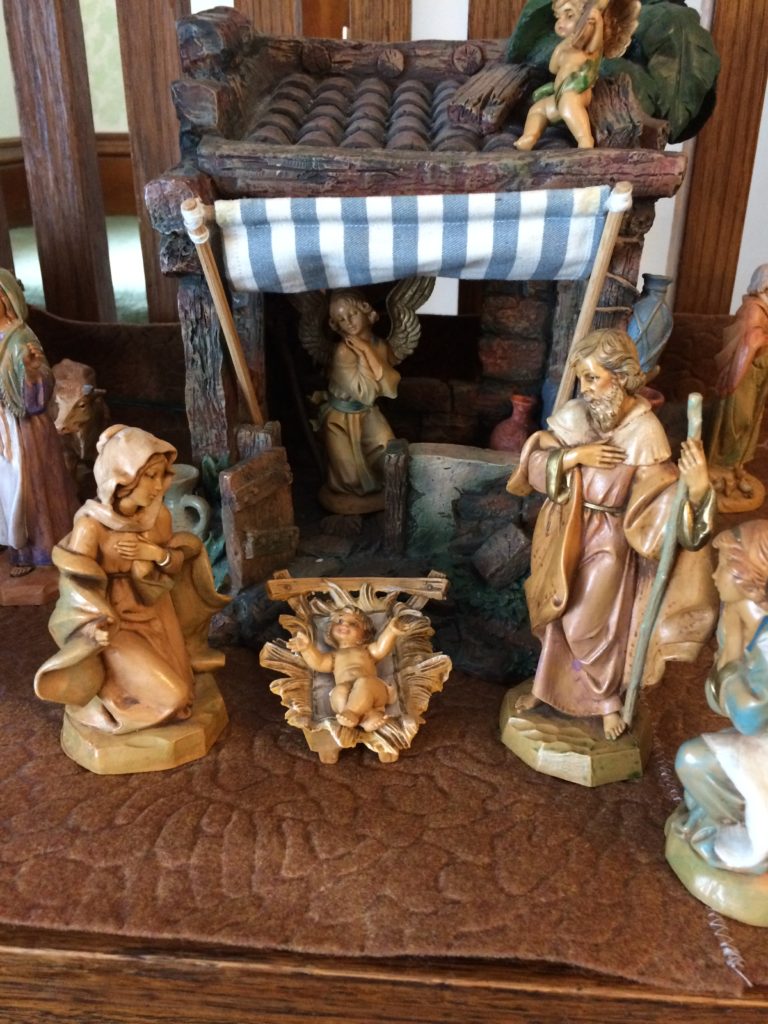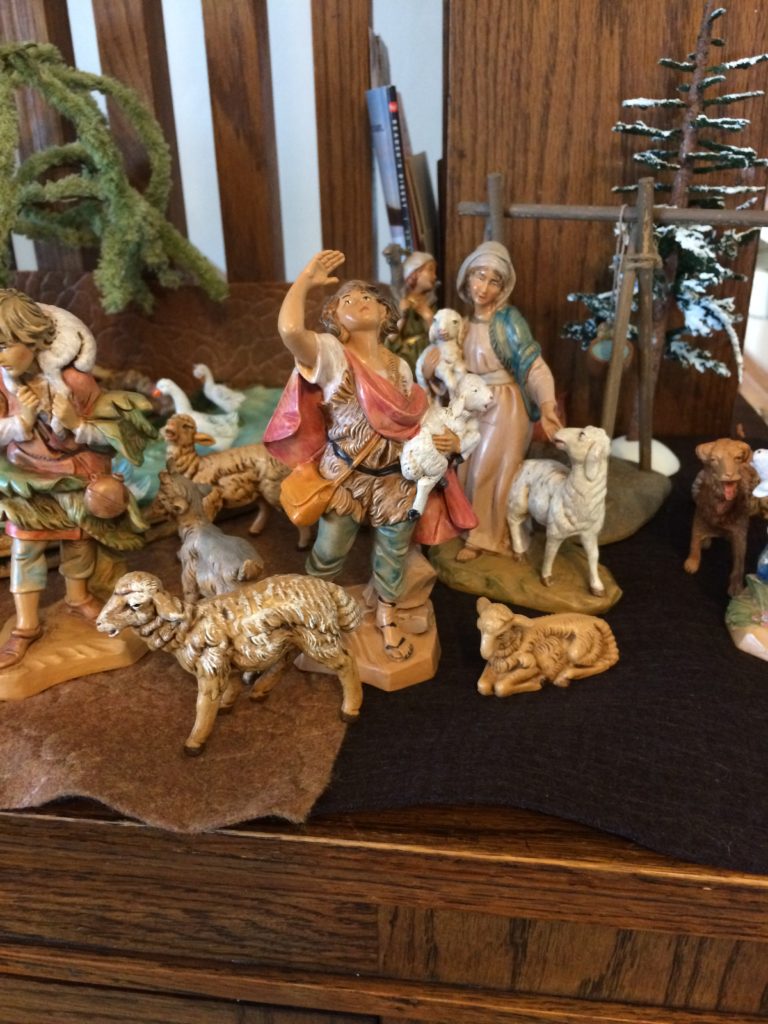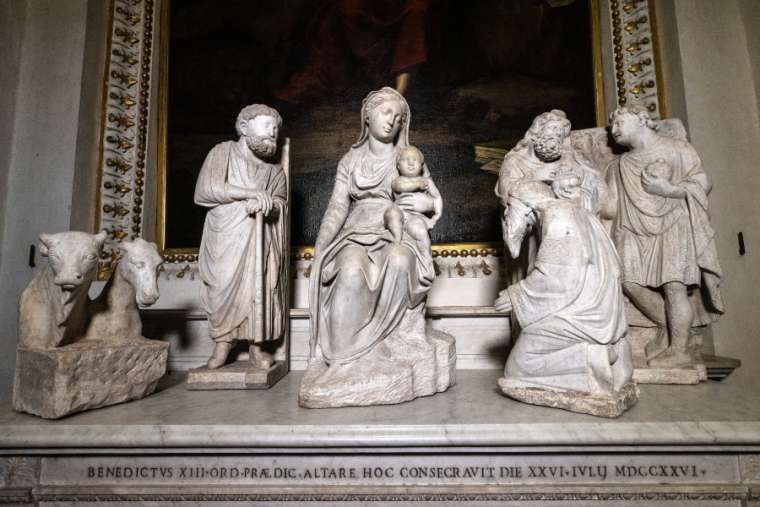Photo Credit: Nativity scene commissioned by Pope Nicholas IV in 1292. Credit: Daniel Ibanez/CNA.
Courtney Mares wrote the article for the Catholic News Agency: Rome Newsroom, Dec 23, 2020 / 11:00 am MT (CNA).- The first known nativity scene figurines are on display this Christmas in one of Rome’s oldest basilicas. I have excerpted some of her text quoted here, and the above photo is from her article.
The First Known Nativity Scene Figurines Can Now Be Seen
As a Christian and a Catholic, I am among thousands of folks who enjoy displaying and rearranging a Nativity Scene (also known as a manger scene, a crib or creche or in Italian, a presepio, presepe or Bethlehem.) This special exhibition, particularly during Advent or Christmas time, represents the birth of Jesus. The three central characters are Jesus as an infant, Mary his mother and Joseph, her husband. Other characters include angels, animals, shepherds, wise men on camels and other Biblical characters.
Three of the most widely-known Nativity Scenes on display are at the White house, the Vatican and in Bethlehem.
Nativity scenes take inspiration from the Gospels of Luke and Matthew whose narrations help us learn about the trip Mary and Joseph took to Bethlehem, the angels visiting the shepherds in the fields, the star and the Magi who followed it to the stable where the baby lay. These accounts provide the central characters for the nativity scene.

Italian churches originally displayed large pieces crafted from terracotta. In the mid 1500’s churches and wealthier people began to display Nativity sets. The sets for in homes were much smaller than the large statues found in churches. Artisans used wax, wood and terracotta. The figurines were dressed in beautiful clothing.
The practice of displaying nativity scenes has spread to practically all Christian countries, each adding its own style, unique to their culture. The home nativity is celebrated in Germany more than anywhere else in the world, where the tradition is to set up the Nativity with the exception of Baby Jesus who arrives on Christmas Eve.
For many years I have collected Fontanini figures. They begin with the holy family and are enhanced with a stable, a tent, animals, and figurines of biblical people. Like folks in Germany, I too, keep baby Jesus in absentia until Christmas Eve, when I place him in the manger after all others have gone to bed. It is a special moment of peace and contemplation for me.
I like the Fontanini figurines because they are sturdy enough for our kids to play with them. Once they are set up, they get rearranged as small children do imaginative play, bigger children note that things are not in their ‘right’ spot, and adults make them look ‘more presentable’. All the while there is discussion about the people of those times-what they might be doing and what they are saying, in anticipation for baby Jesus’ coming. After Christmas, we continue to move the ‘wise guys’ around until Jan 6th when they arrive at the stable to worship the newborn Christ child as Magi bearing gifts.

Distinctive traditions around the nativity scene have been created around the world. I was amazed at the large and intricate displays in shopping malls in Mexico, when I visited there. They display cities and figurines of various sizes. In Rome, the statues in church side altar areas are large, usually in some kind of stone and carved beautifully.
So, it was with interest that I heard there was a first known nativity. Of course, there would be a first nativity scene, but who would think it was not already on public display somewhere or lost to the ravages of time.
Saint Bonaventure tells us in his book The Life of Saint Francis of Assisi, that St. Francis of Assisi, created of the first living nativity in Greccio, Italy, in 1223. Realizing that the chapel of the Franciscan hermitage would be too small to hold the congregation for Midnight Mass, he found a niche in the rock near the town square and set up the altar.
St. Francis was concerned that people were more interested in the gifts they got than of the real reason for Christmas-the coming of Jesus. He thought the living nativity would help focus on the true message of Christmas.
Fifteen days before Christmas, Saint Francis asked a friend to help him prepare “to bring to life” the memory of Christ’s birth in Bethlehem in this small town. Differing accounts recount that St, Francis or his friend placed the hay, the ox and ass in the rock niche to set the stage for the Christmas scene, along with people representing the holy couple. The priest “solemnly celebrated the Eucharist over the manger, showing the bond between the Incarnation of the Son of God and the Eucharist.”
St. Bonaventure wrote of that night in his biography of St. Francis, “A certain valiant and veracious soldier, Master John of Grecio, who, for the love of Christ, had left the warfare of this world, and become a dear friend of this holy man, affirmed that he beheld an Infant marvellously beautiful, sleeping in the manger, Whom the blessed Father Francis embraced with both his arms, as if he would awake Him from sleep.” (from Wikipedia.org)
A living nativity is fabulous and enchanting, but not practical to be kept for viewing over time. You’ve got to feed and water the animals daily. Then there is the clean-up.
Pope Nicholas IV (The first Franciscan pope) was inspired by St. Francis of Assisi when he commissioned the nativity figurines in 1292, that were recently displayed in Rome. They provide a more static scene, and one that does not have to be maintained daily.
Sante Guido, an art historian and professor at the Pontifical Gregorian University, reports that five of the marble statues in the nativity scene today are completely original to the 13th century. Even though it is unclear how many figures in total made up the nativity scene commissioned by Nicholas IV, these marble figures from the original set exist today: St. Joseph, the three Magi, and a single work depicting both a cow and a donkey along with Mary and the child.
“In the history of Christianity there are many depictions of the nativity of Christ, of course, even on the early Christian sarcophagi, but also in the Romanesque cathedrals and in the Gothic cathedrals there are depictions of an episode in the life of Christ: his birth,” Guido said.
“Here instead we have the representation of the nativity, according to the spirit of St. Francis, so this nativity is the first nativity scene in history. It is not only a representation of the nativity, but it is a nativity scene.”
This means that this nativity scene was present when St. Cajetan experienced an apparition of the Child Jesus in the Chapel of the Nativity on Christmas night in 1517 and when St. Ignatius of Loyola chose to offer his first Mass in this chapel in 1538.
The Italian art historian and restorer noted that this is not the first depiction of Christ’s birth in Christian history, but it is the first nativity scene in the form as it is known today.
Nearly 800 years later, we still hear religious leaders echoing St. Francis, saying the true meaning of Christmas is becoming lost. Yet at the same time, we see nativities everywhere come to life in small and larger ways.
The first biographer of St. Francis, Thomas of Celano wrote that someone present at the Mass with that first living nativity had a vision of the baby Jesus himself lying in the manger. And isn’t the prospect of that vision inherent in all of us?
Resources:
First Known nativity scene figurines can now be seen in St. Mary Major Basilica by Courtney Mares, Dec. 23, 2020/ 11:00 am MT(CAN) at: https://www.catholicnewsagency.com/news/first-known-nativity-scene-figurines-can-now-be-seen-in-st-mary-major-basilica-68998
Nativity Scene from Wikipedia.org at: https://en.wikipedia.org/wiki/Nativity_scene#:~:text=Saint%20Francis%20of%20Assisi%20is,been%20shown%20Jesus’s%20traditional%20birthplace.
8 things you should know about the history of Nativity Scenes, Guideposts.org at: https://www.guideposts.org/inspiration/inspiring-stories/stories-of-faith/8-things-you-should-know-about-the-history-of
The Story of the first Nativity Set from Monastery Icons at:
https://www.monasteryicons.com/product/story-first-nativity-set/did-you-know
The History of the Nativity Scene from Festive Nativities at: https://festivenativities.com/history-nativity-scene/
